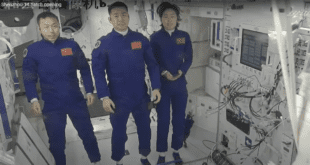by Blaine Curcio and Jean Deville
 As part of the partnership between SpaceWatch.Global and Orbital Gateway Consulting we have been granted permission to publish selected articles and texts. We are pleased to present “Dongfang Hour China Aerospace News Roundup 26 April – 2 May 2021”.
As part of the partnership between SpaceWatch.Global and Orbital Gateway Consulting we have been granted permission to publish selected articles and texts. We are pleased to present “Dongfang Hour China Aerospace News Roundup 26 April – 2 May 2021”.
1) Chinese Space Station: launch of the core Module Tianhe on-board Long March 5B
Jean’s Take
On April 29 2021, China successfully sent the first module of the Chinese Space Station into orbit. The module was a 22.5 ton core module called Tianhe (天和, or “heavenly peace”). It was launched aboard a Long March 5B, a variant of the Long March 5 that doesn’t have a second stage and has an extended payload fairing. This is necessary for the Tianhe module as it is quite huge: over 16m long, 22.5 t, nearly the limit payload capacity of the LM5. It is a beast of a rocket, able to put 23 tons in LEO, which puts it in the same category as a Delta 4 Heavy, an Ariane 5, or a Falcon 9.. Long March 5 is one of China’s new generation rockets, and launched from the Wenchang launch site, China’s coastal launch site in the southern island of Hainan, used for Long March 5, 7 and 8 launches.
Tianhe is rightfully named the core module: it will be the centerpiece of the station which will host living quarters for the taikonauts, a bathroom, a kitchen, it will also be the main control unit (attitude, trajectory control), handles the fuel, power and air management systems. It is designed to host 3 taikonauts and can hold up to 6 taikonauts during rotations (with an additional Shenzhou spacecraft docked). It is composed of two cylindrical parts and one spherical node at the end, which notably hosts 4 of the docking ports. The Tianhe module will be joined next year by the Mengtian and Wentian experimental modules, which will connect to the docking ports.
In 2024, the Chinese space station will be joined by a space telescope called Xuntian, which will not be physically connected to the station but will evolve in the vicinity, and docking only for maintenance purposes. This telescope will be an impressive beast: 2m of aperture, an angular resolution of 0.15 arcseconds (slightly lower res than the Hubble telescope) but perhaps most impressively, a field of view of 1.1° x 1.1°.
The deployment of these different building blocks will also require multiple crewed Shenzhou missions and Tianzhou cargo missions. Hao Chun, the director of the CMSA, described the deployment process in an interview to Xinhua on April 29. Basically, the deployment of the CSS would be split into two phases:
- Key Technology Verification Phase (关键技术验证阶段) in 2021: this includes the deployment of Tianhe (last week), and the launch of 2 Tianzhou and Shenzhou The first Tianzhou mission will take place in May, shortly after followed by the first Shenzhou mission in June, Shenzhou-12. Shenzhou-12 would bring 3 taikonauts for a 3-month stay. The next Tianzhou and Shenzhou missions would take place in September and October respectively, and the team of taikonauts would remain 6 months in-orbit, the standard duration for the CSS.
- Orbital Construction Phase (空间站在轨建造阶段) in 2022: during this phase, there would be 6 launches in total: two of Long March 5B to put into orbit the Mengtian and Wentian experimental modules. And also 2 Shenzhou crewed and 2 Tianzhou cargo missions.
All in all, it will represent 11 missions: 3 module deployment missions, 4 crewed, and 4 cargo. Also, last fun fact: these missions launch on different rockets: 5B for the modules, 7 for the cargo, and 2F for the crewed missions.
Blaine’s Take

Big congratulations to the Chinese Space Program, and everyone involved with the LM-5B/Tianhe missions. Just a few small points to add to Jean’s very comprehensive technical summary: once again, we saw this major space event becoming a major pop culture event too. In recent years, LM-5 launches in Hainan have attracted beachgoers, with some pretty epic photos coming out of it. This time, we saw the Xi’an Symphony Orchestra playing on the beach with the LM-5B launch taking place in the background, and with a bunch of attendees (of the concert and the rocket launch) sitting in front of the orchestra watching the launch take place. I would say this is but the latest example of a clear government push towards popularizing space, or at a minimum, popularizing the major accomplishments of the Chinese space program. This is part of a broader trend, in my opinion, of China’s Central Government becoming aware of the potential of space, not only for economic development but for soft power, the inspiration of people, etc. That being said, this week there was another such example of the Central Government seemingly recognizing the potential of space, but this time, for connecting the masses.
Some sources: Interview of Chief Designer of CSS Yang Hong, 三体引力波,CMSA.
2) China SatNet
Blaine’s Take
Major news update on Thursday 29 April which first came in the form of a press release from the State-Owned Assets Supervision and Administration Commission (SASAC), a very powerful Central Government body that oversees and in some cases administers state-owned enterprises. The press release announced the creation of a China Satellite Networks Group Company (中国卫星网络集团有限公司), potentially SatNet for short, and puts that company under the direct administration of SASAC. SatNet is tasked with deploying and operating China’s LEO broadband constellation, widely speculated to be GuoWang. Quite a lot to unpack from this piece of news:
The creation of a SatNet company at this level of the SOE hierarchy is hugely significant. SatNet is, at least in theory, at the same level in the hierarchy as CASC, CASIC, and the big 3 telcos (all of which are also directly controlled by SASAC). If we compare this to the previous arrangement, you had China’s biggest broadband project being done by CASC (Hongyan), and another by CASIC (Hongyun), with both projects involving subsidiary companies with multiple shareholders (for example, Hongyan’s operating company, MacroNet, has shareholders including CASC, China Telecom, and CETC). This would have meant, presumably, that projects like Hongyan would have mostly used the technology of CASC, Hongyun would have used technology for CASIC, and the innovation and competition would have occurred in the long-term after we find out how these constellations work.
On the other hand, the current situation with SatNet being at the same level as CASC, CASIC, the telcos, etc., means that it should, at least in theory, have a lot more freedom of choice in its sourcing options. Want to launch a bunch of your satellites on some of the Kuaizhou rockets that Expace is building? If you’re a CASC subsidiary, that could be tricky since Kuaizhou is CASIC. But if you’re a company at the level of SatNet, you can pick and choose the best options at the sourcing level–that is, the best satellite technology, the best launch technology, etc.
The creation of SatNet, and to a certain extent its location in Xiong’an, also allows the state to have a lot of centralized control over China’s LEO broadband mega constellation. Previously, Hongyan would have been a project controlled largely by a company that is itself under SASAC (i.e. CASC), in which case SASAC has a sort of “second-order of influence”. By having a company that is directly under SASAC, and in a place like Xiong’an–a new city near Beijing where lots of “non-core” governmental functions are being moved–it should allow for a pretty direct line of control from Central Government to SatNet. A few other points on Xiong’an–fascinating area to look into. Technically a New District of Baoding City, Xiong’an is geographically around 100km South of Beijing, and around 100km Northwest of Tianjin (labelled as the “1” on the above map). Until a few years ago, it was a bunch of farmland, but then the Central Government announced plans to move many government functions there, which caused property prices in Xiong’an to skyrocket. Anyway, back to SatNet–
 Final point–the signing agreement between SatNet and Xiong’an was presided over by Han Zheng, a Politburo Standing Committee Member, Deputy Party Secretary of the State Council, and First Vice Premier of the PRC. This was apparently part of a day trip by Han Zheng from Beijing to Xiong’an, during which time he conducted some standard visits (schools, etc.), and presided over a meeting of the Beijing-Tianjin-Hebei Coordinated Development Leading Group, a group dedicated to promoting regional economic integration in the Jing-Jin-Ji area of Beijing, Tianjin, and Hebei. Han noted that SatNet would be the first Central Enterprise registered in Xiong’an.
Final point–the signing agreement between SatNet and Xiong’an was presided over by Han Zheng, a Politburo Standing Committee Member, Deputy Party Secretary of the State Council, and First Vice Premier of the PRC. This was apparently part of a day trip by Han Zheng from Beijing to Xiong’an, during which time he conducted some standard visits (schools, etc.), and presided over a meeting of the Beijing-Tianjin-Hebei Coordinated Development Leading Group, a group dedicated to promoting regional economic integration in the Jing-Jin-Ji area of Beijing, Tianjin, and Hebei. Han noted that SatNet would be the first Central Enterprise registered in Xiong’an.
And a few things now that are worth thinking about:
- How big will SatNet be? CASC, CASIC, and the telecoms are all well over 100,000 employees. SatNet would presumably start relatively lean, but would still presumably be a formidable organization.
- How will SatNet be staffed? Presumably many of the most qualified people to work at SatNet are currently working at CASC, CASIC, the telcos, or indeed, some of the commercial space companies. Might we start to see a talent war among space entities?
- What is SatNet’s mandate? Will it be responsible to build and maintain the constellation, but then also act as a reseller (a la the telcos and their building the terrestrial network then selling direct to consumers)? Or will it simply build the infrastructure, then commercial companies can distribute capacity as resellers?
Jean’s Take
Those are all excellent questions. I would also wonder:
4) what will the timeline of the roll-out of China’s LEO broadband constellation look like (I’d speculate that it’s likely to come very soon, with the New Infrastructures policy encompassing satellite internet, the calls for the deployment of satellite internet during the two sessions, and just the pressure coming from Starlink’s rapid deployment).
5) Who will be the end-users of China’s LEO broadband constellation? Starlink, while serving multiple market segments, seems to have consumer broadband as one of the main targets. This will be a bit trickier for China due to the good existing broadband infrastructure on the ground, but also the higher price sensitiveness of communities living in rural areas deprived of broadband. The situation may be better in Belt and Road countries with poor broadband infrastructure, but the point of price sensitiveness remains.
3) Long March 6 launches a Batch of 9 Smallsats into Orbit, many payloads of interest
Jean’s Take
On April 27th, China launched an impressive launch share mission on-board a Long March 6: 9 satellites were sent into space, most coming from completely different customers and for different purposes.
These satellites were:
-
- The first two satellites of the Qilu constellation were launched: Qilu-1 and Qilu-4. Qilu-1 is a SAR remote sensing satellite, equipped with a laser ISL (inter-satellite links) payload, and manufactured by Shanghai Microsate. Qilu-4 on the other hand is a high-resolution panchromatic remote sensing satellite. Interestingly, this satellite was made by a different manufacturer: a very low key company called Gengyu Muxing (耕宇牧星(北京)空间科技有限公司)。 Both satellites belong to the Shandong Institutes of Industrial Technology (山东产业技术研究院), which is what looks like a provincial-level institute set up in 2015 to stimulate innovation in Shandong’s local industry. It is based in the province’s capital Jinan. Both remote sensing satellites will be dedicated to surveying Shandong and providing data to foster innovation in the province.
- Foshan-1 is a high res panchromatic remote sensing satellite, meant to be a technology verification platform of the Foshan-based Jihua Laboratory (先进制造科学与技术广东省实验室). Jihua Laboratory is a provincial level lab set up in 2017. It focuses on industrial research, with applications ranging from automation, smart agriculture, robotics, etc. Foshan-1 is understood to be an in-orbit technology verification remote sensing platform. The satellite was manufactured by Gengyu Muxing (耕宇牧星(北京)空间科技有限公司).
- Zhong’an Guotong-1 satellite (also called Hangsheng-1): we mentioned this satellite in an episode of Dongfang Hour last year. At the time, Hangsheng, a commercial satellite manufacturer from Changsha, had just signed a deal with Shenzhen-based company Zhong’an Guotong to build a constellation of 12-15 remote sensing satellites. This signature was announced at the time during the 40th anniversary of the city of Shenzhen. The constellation would be fully deployed by 2022 according to the news back then.
The satellite (also known as Hangsheng-1) was also an in-orbit verification experiment for the payloads of several other commercial companies, including Exatech 西安艾可萨科技 (Space chips), Yunyao Yuhang 云遥宇航 (GNSS occultation), SpaceD, NUDT, etc. - Guodian Gaoke’s Tianqi-9 satellite, developed by ASES Space, was among the payloads. Guodian Gaoke is resuming the deployment of its Tianqi LEO IoT constellation with the first launch in 2021, after a (relatively) aggressive deployment agenda in 2020 (Tianqi 5, 6, 8, 10, 11 all launched last year). Example of Guodian Gaoke uses cases with actual customers here.
- Origin Space’s NEO-1: a technology verification satellite, meant to trial the capture of a small celestial body and various orbital maneuvers. It was manufactured by ASES Space.
- Golden Bauhinia-1-01 and -02 are two remote sensing satellites, gathering data in the visible light. According to the official China Space News industry media, the manufacturer and user of the satellites are Zero Gravity Labs.
- The 9th Satellite Built by MinoSpace Gets Launched
Chinese commercial satellite manufacturer MinoSpace announced the launch of its 9th satellite on Tuesday, occurring on a LM-6 rocket from Taiyuan. The Taijing-2 satellite (泰景二号) will be used primarily for remote sensing and is the third satellite launched to be based on the MN-50 platform.
Some takeaways:
- Strengthening of the commercial space ecosystem: deployment, manufacturing, TT&C services (Satellite Herd provided TT&C services to three of the satellites, Tianlian offering TT&C services to some of the other satellites.).
- Massive growth of China’s commercial remote sensing infrastructure: all of the satellites except two are for remote sensing. And includes China’s second commercial SAR satellite (Qilu). Geespace has been over the past weeks also showing signs of joining the battle for SAR (and the chief designer of the SAR payload on Qilu now works for Geely).
- China’s remote satellites now represent 20-25% of the total number of such satellites globally, according to a recent report by Satellite & Internet.
Last thing worth mentioning: the Yunyao Yuhang GNSS occultation payload on-board the Hangsheng-1 satellite. This is a rather neat technique of gathering information on the Earth’s atmosphere. The satellite, in LEO, is able to receive signals from GNSS satellites that are in higher orbit (MEO), but the refraction phenomenon due to propagation through the atmosphere bends the radio waves. The “amount of bending” can provide information on the atmosphere.
Blaine’s Take
What a launch and this is now seemingly something we’re seeing a few times per year, with this launch being similar to a Long March-6 occurring in November last year, which included 13 satellites for a variety of customers (and which we covered on DFHour Episode 7). Definitely, SAR is a hot topic in China these days, with Commsat also getting more into SAR recently, and Beijing Smart Satellite also pushing more into SAR. I suspect this might be partially due to the massive amount of optical satellites that have been launched via CHEOS and CGSTL’s Jilin-01, and also because we have discussed before, EO is seen as being more open to commercial players than other areas of satellite operation (comms).
Interesting to see a satellite being launched by a company in Foshan–another example of a trending topic of the emergence of Guangdong’s space sector. Foshan is a pretty wealthy and developed city near Guangzhou that is home to major manufacturers such as Midea and Galanz, among others. Jihua Laboratories seems to be located in an industrial park about halfway between the municipal government of Foshan and the Provincial Government of Guangdong (a leisurely 13km trip to each). It will be interesting to see how the Guangdong space sector continues to develop, there are a lot of wealthy, specialized companies in the province that could potentially have some usage for space applications.
Finally, this is yet another example of an SOE (in this case SAST) benefiting from an increasing number of commercial companies. SAST provided the Long March-6 for this launch, and with much of the payload being commercial companies, it represents decent business for SAST.
This has been another episode of the Dongfang Hour China Aero/Space News Roundup. If you’ve made it this far, we thank you for your kind attention, and look forward to seeing you next time! Until then, don’t forget to follow us on YouTube, Twitter, or LinkedIn, or your local podcast source.
Blaine Curcio has spent the past 10 years at the intersection of China and the space sector. Blaine has spent most of the past decade in China, including Hong Kong, Shenzhen, and Beijing, working as a consultant and analyst covering the space/satcom sector for companies including Euroconsult and Orbital Gateway Consulting. When not talking about China space, Blaine can be found reading about economics/finance, exploring cities, and taking photos.
Jean Deville is a graduate from ISAE, where he studied aerospace engineering and specialized in fluid dynamics. A long-time aerospace enthusiast and China watcher, Jean was previously based in Toulouse and Shenzhen, and is currently working in the aviation industry between Paris and Shanghai. He also writes on a regular basis in the China Aerospace Blog. Hobbies include hiking, astrophotography, plane spotting, as well as a soft spot for Hakka food and (some) Ningxia wines.
 SpaceWatch.Global An independent perspective on space
SpaceWatch.Global An independent perspective on space




